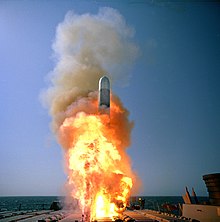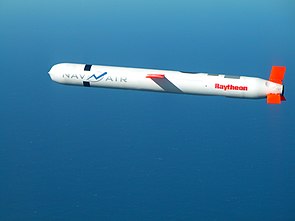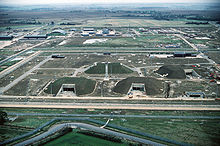BGM-109 Tomahawk
| R / UGM-109 Tomahawk | |
|---|---|
| General Information | |
| Type | Cruise missiles |
| Manufacturer | General Dynamics (until 1997), Raytheon |
| development | 1972 |
| Commissioning | 1983 |
| Unit price | 500,000 to 2.03 million US dollars |
| Technical specifications | |
| length | 5.56 m (18 ft 3 in) 6.25 m (20 ft 9 in) with booster |
| diameter | 51.81 cm (20.4 in) |
| Combat weight | 1425 kg |
| span | 2.67 m (8 ft 9 in) |
| Drive First stage Second stage |
Turbofan solid fuel booster |
| speed | 878 km / h (244 m / s) |
| Range | up to 2500 km |
| Furnishing | |
| Target location | Inertial navigation platform plus TERCOM |
| Warhead | Fragmentation warhead 450 kg TNT, bomblets or W80 nuclear up to 150 kT |
| Weapon platforms | Ships, submarines, trucks |
| Lists on the subject | |
The BGM-109 Tomahawk is a cruise missile produced by the American manufacturer Raytheon . Initially, it was primarily intended to be land-based for use with nuclear warheads , but today it is stationed on warships of the US Navy as well as submarines of the US and Royal Navy and is mainly used with conventional warheads to combat enemy land targets.
The tomahawks are now among the US and British first-strike weapons in every armed conflict and are increasingly taking over the tasks of manned bombers . Without the risk of endangering pilots or aircraft, they can penetrate deep into enemy territory, destroy bunkers , radar systems , missile silos and command posts or weaken the enemy infrastructure .
development
In 1972 General Dynamics (now Raytheon Missile Systems ) began developing the AGM / BGM / RGM / UGM-109 Tomahawk with the aim of developing a cruise missile that could be used by ships, submarines, aircraft and vehicles. It should be used against strategic land targets as well as ships. In 1977 the airborne version AGM-109 was canceled in favor of the AGM-86 ALCM . The first launch from a submarine took place in 1976, from a vertical launch system in 1979 and finally from a surface ship in 1982. From 1983 the cruise missiles were delivered to the US armed forces in Europe. Along with the Pershing 2, they were the subject of the controversial NATO double decision .
technology

The Tomahawk can be launched from ships using a Vertical Launching System (VLS). The Armored Box Launcher is no longer used. When launching above water, the missile is launched with a start-up rocket (booster). After the booster burns out, the Williams International -F107-WR-402- turbofan engine starts and accelerates the missile to cruising speed. The submarine-supported variant can be fired from a VLS or from the 533 mm standard torpedo tubes. After leaving the submarine, a booster ignites and drives the guided weapon to the surface of the water. After the water surface has been pierced, the protective cover surrounding the missile and the booster are thrown off and the turbofan engine ignites. The cruise flight usually takes place at an altitude of less than 200 m. If mountains have to be flown over, the cruising altitude must be correspondingly higher. The flight altitude can be between 30 and 90 m over flat terrain. The missile can avoid obstacles independently. The cruising speed is around 880 km / h. The low altitude and the low IR signature of the engine make it difficult to locate and combat.
The Block I variant uses a TAINS (TERCOM Assisted Inertial Navigation System) for navigation, which is based on terrain points. In addition, an inertial navigation platform is used. With these two systems, an accuracy ( CEP ) of less than 50–80 m should be achievable. The Block II variant uses its own radar system, Terrain Contour Matching (TERCOM) and Digital Scene Matching Area Correlation (DSMAC), which compares the terrain overflown with stored data in order to find the target. The mean accuracy should be around 30–50 m. The Block III variant , which has been in use since 1994, also uses the satellite-based Global Positioning System (GPS) to find its destination. The mean accuracy should be 10–15 m.
Depending on the version, a cruise missile costs between 600,000 and a million US dollars , and according to the US Department of Defense in the Second Gulf War, it costs almost 500,000 dollars if larger quantities are purchased .
Versions

- AGM-109 Tomahawk: Airborne version. Can optionally be equipped with a nuclear warhead or a conventional fragmentation warhead. Range 2500 km. Development in favor of the AGM-86 ALCM discontinued.
- R / UGM-109A Tomahawk Block I: TLAM-N (Land Attack Missile-Nuclear) equipped with the W80-0 nuclear warhead with a selectable explosive power of 5 to 150 kT . At the end of 2008, the US Navy still had 100 of these cruise missiles in stock. The last TLAM-N were taken out of service in 2013.
- BGM-109G Gryphon Block I: GLCM (Ground-Launched Cruise Missile) Procured as part of NATO's dual decision . Equipped with the W84 nuclear warhead with a selectable explosive power of 0.2–150 kT . Range 2500 km. The All-Up-Round (AUR) canister was used as a launch pad for launching four cruise missiles.It was mounted on a modified version of the 10-t truck ( MAN gl ) of the type KAT I of MAN Nutzfahrzeuge and was called Transporter-Erector -Launcher (TEL) received. This type was stationed in the Federal Republic of Germany, Great Britain, Italy, Belgium and the Netherlands. With the ratification of the INF Treaty in 1987, this version was completely disarmed.
- R / UGM-109B Tomahawk Block I: TASM (Anti-Ship Missile) was used as anti-ship missiles used (is no longer being used). Range 460 km. Warhead 454 kg armor-piercing.
- R / UGM-109C Tomahawk Block II: TLAM-C (Land Attack Missile-Conventional) is used with a conventional WDU-25 / B 454 kg fragmentation warhead against land targets. Range 1,300 km.
- R / UGM-109D Tomahawk Block II: TLAM-D (Land Attack Missile Conventional-Dispenser) is deployed against land targets with 166 BLU-97 bomblets . Range 870 km.
- R / UGM-109C Tomahawk Block III: Used with a conventional WDU-36 / B 317 kg penetration warhead against bunkered land targets. Improved precision. Range 1650 km.
- R / UGM-109E Tomahawk Block III: TMMM (Tomahawk Multi-Mode Missile). Version with BLU-106B or BLU-97B bomblets. Forerunner of the Tactical Tomahawk . Development stopped. Range over 1600 km.
- R / UGM-109H Tomahawk Block III: THTP (Tomahawk Hard Target Penetrator). Version with penetration warhead against land targets and ships. Forerunner of the Tactical Tomahawk . Development stopped. Range over 1600 km.
- R / UGM-109E Tomahawk Block IV: TacTom (Tactical Tomahawk). Version from 2004. Can be reprogrammed to another destination during the flight using a 2-way satellite connection or switch to one of up to 15 saved alternative destinations. In order to make a corresponding decision possible, they carry a camera that shows the task officer the target area. In addition, they should be able to circle over a target area for several hours. Range over 1650 km. This is to make the Tomahawk Network-Centric-Warfare -capable. The Tactical Tomahawk can optionally be equipped with a fragmentation or penetration warhead and bomblets. In February 2010 the mark of 2000 cruise missiles produced was exceeded and production ended at the end of 2018.
- R / UGM-109H Tomahawk Block V: TTPV (Tactical Tomahawk Penetrator). Used with conventional WDU-43 / B penetration warheads against bunkered land targets.
- R / UGM-109H Tomahawk Block V: New version based on the TTPV. This Tomahawk version exists either as a retrofit program or as a new production and will replace all Tomahawk versions from 2019. The production costs are to be reduced significantly through new production methods and a modular design . The weapon purchaser is thus able to adjust the price by selecting different target search systems. Range over 1650 km. The Joint Multiple Effects Warhead System (JMEWS) is used as a warhead.
- In May 2009 Raytheon announced that it would develop a conversion kit for the R / UGM-109E to make it an anti-ship missile . For this purpose, the Maritime Strike Tomahawk (MST) receives an AESA radar, a SIGINT sensor for locating and identifying targets at great distances, as well as an improved data link. The penetration warhead is to be replaced by a large shaped charge .
commitment
- The first massive use of tomahawks took place in 1991 in the Second Gulf War during Operation Desert Storm . According to reports from the United States Navy , 297 tomahawks were used. Of these, nine got stuck in the launch tubes and six fell into the sea after launch, so that 282 were successfully launched. According to US data, two cruise missiles were shot down by the air defense. Iraq reported 29 kills.
- Operation Southern Watch January 1993: 45 tomahawks hit targets in Iraq.
- Operation Bushwhacker June 1993: 23 tomahawks hit targets in Iraq.
- Operation Deliberate Force 1995: 13 tomahawks against anti-aircraft positions and the headquarters of the Bosnian Serb army near Banja Luka .
- Operation Desert Strike 1996: US warships and submarines fired 31 tomahawks against air defense positions and command posts in Iraq. With Lieutenant Erica Niedermeier, a woman from the USS Laboon (DDG-58) fired a tomahawk cruise missile for the first time in the Persian Gulf .
- Operation Infinite Reach 1998: 13 tomahawks against a suspected chemical weapons factory in Sudan and 66 against three targets in Afghanistan .
- Operation Desert Fox 1998: 325 tomahawks against chemical weapons and ballistic missile production facilities in Iraq.
- Operation Allied Force 1999: 218 tomahawks from US warships against targets in Serbia . Another 20 tomahawks are used by Royal Navy submarines.
- Afghan War 2001: US warships and submarines used 50 tomahawks against suspected Al-Qaeda bases in Afghanistan. An unknown number of tomahawks are also used by Royal Navy submarines.
- Operation Iraqi Freedom 2003: 802 tomahawks against targets in Iraq
- December 17, 2009: Use of four tomahawks against suspected Al-Qaeda bases in Yemen and Somalia .
- March 19, 2011: As part of the international military operation in Libya , 162 tomahawks were used by submarines and destroyers of the US Navy and one submarine of the Royal Navy to enforce Resolution 1973 of the UN Security Council . Both the classic variant and more modern TacToms were used. Air defense positions and air force facilities were mainly selected as targets. The US national participation is called Operation Odyssey Dawn , the British national participation Operation Ellamy .
- On September 23, 2014, the USS Arleigh Burke and USS Philippine Sea (CG-58) launched Tomahawk cruise missiles against targets in Syria . A total of 47 Tomahawk were used against Islamic State (IS) institutions .
- On October 13, 2016, five Tomahawk cruise missiles were launched against targets in Yemen . The launch took place from the destroyer USS Nitze against radar stations of the Houthi . The attack was in response to anti-ship missiles launched the day before by the Houthi against US Navy ships.
- During the air raid on the asch-Schaʿirat military airfield on April 7, 2017, US President Donald Trump fired 59 Tomahawk cruise missiles from the ships USS Porter and USS Ross at the asch-Schaʿirat military airfield , about 30 km southeast of Homs . This was in response to the alleged April 4, 2017 chemical warfare agents carried out attack by the Syrian army in the province of Idlib in Syria. Syria and its ally Russia denied the use of such weapons and referred to a rebel weapons depot that had been hit.
distribution
-
 United States - In stock since 1983
United States - In stock since 1983 -
 United Kingdom - In 1998 the Royal Navy ordered 55 UGM-109C Tomahawk, which were delivered in three lots through 2003.
United Kingdom - In 1998 the Royal Navy ordered 55 UGM-109C Tomahawk, which were delivered in three lots through 2003. -
 Netherlands - In 2005 the Koninklijke Marine of the Netherlands ordered 30 tomahawks but canceled the purchase in 2007.
Netherlands - In 2005 the Koninklijke Marine of the Netherlands ordered 30 tomahawks but canceled the purchase in 2007. -
 Spain - In 2006 the Spanish Navy ordered 24 tomahawks, but canceled the purchase in 2009 due to budgetary concerns.
Spain - In 2006 the Spanish Navy ordered 24 tomahawks, but canceled the purchase in 2009 due to budgetary concerns.
Former deployment as part of the NATO dual decision

The medium-range systems of the USA, which can be equipped with nuclear equipment, were to be stationed in the NATO countries from 1983 to 1987 as part of nuclear participation :
|
|
Number planned | Number stationed | Stationing area | US missile unit, base | US missile unit headquarters |
|---|---|---|---|---|---|
|
|
96 pieces | 64 pieces by March 1986 |
Rhineland-Palatinate: Hunsrück area (including Wüschheim ) | Wing 4: 38th Tactical Missile Wing, Wüschheim Air Station, previously stored at Hahn Air Base |
with headquarters at Sembach Air Base |
|
|
96 pieces | 96 pieces by December 1983 |
Berkshire : Greenham Common | Wing 1: 501st Tactical Missile Wing, RAF Greenham Common |
headquartered at RAF Mildenhall Air Force Base |
|
|
64 pieces | 16 pieces by December 1987 |
Cambridgeshire County : Molesworth | Wing 5: 303rd (ex-550th) Tactical Missile Wing, RAF Molesworth |
headquartered at RAF Mildenhall Air Force Base |
|
|
112 pieces | 112 pieces by March 1984 |
Sicily: Comiso | Wing 2: 487th Tactical Missile Wing, Comiso Air Station |
with headquarters at Torrejon Air Base in Spain |
|
|
48 pieces | 16 pieces by March 1985 |
Namur Province: Florennes | Wing 3: 485th Tactical Missile Wing, Florennes Air Base |
with headquarters at Sembach Air Base, Germany |
|
|
48 pieces | no | planned: North Brabant; Woensdrecht | Wing 6: 486th Tactical Missile Wing, Woensdrecht Air Base |
with headquarters at Sembach Air Base, Germany |
| total | 464 pieces | 304 pieces |
Web links
- Military Today
- Detailed Description (English)
- BGM-109 Tomahawk - Global Security (English)
- Raytheon (General Dynamics) A / B / R / UGM-109 Tomahawk - Designation Systems (English)
Individual evidence
- ^ BGM-109 Tomahawk. In: fas.org. Federation of Atomic Scientists., September 22, 2016, accessed April 13, 2017 .
- ↑ AGM-109 / BGM-109 Tomahawk. (PDF) In: forecastinternational.com. Forecast International Inc., accessed April 13, 2017 .
- ↑ Fas.org
- ↑ a b c Richard Scott: USN confirms Block V designation for modernized Tomahawk cruise missile. In: janes.com. Jane's Missiles & Rockets, January 28, 2019, accessed January 30, 2019 .
- ^ A b Richard Burgess: Raytheon Looking to Next-Generation Long-Range Attack Weapon for Navy. In: seapowermagazine. Seapower Magazine, January 10, 2018, accessed January 30, 2019 .
- ↑ Aviationweek ( page no longer available , search in web archives )
- ^ Time Almanac 2001, p. 365, ISBN 1-929049-12-9
- ↑ Archive link ( Memento from December 18, 2014 in the Internet Archive )
- ↑ Coalition Against Gadhafi Growing. (No longer available online.) March 19, 2011, formerly in the original ; accessed on May 26, 2019 . ( Page no longer available , search in web archives )
- ↑ BBC.com , accessed September 24, 2014
- ↑ centcom.mil ( memento from September 25, 2014 in the Internet Archive ), accessed: May 26, 2019
- ↑ 20min.ch , accessed October 24, 2014
- ^ Dan Lamothe: Navy launches Tomahawk missiles at rebel sites in Yemen after attacks on US ships. In: www.washingtonpost.com. The Washington Post, accessed October 17, 2016 .
- ^ Syria: USA attack Assad's air force base. In: zeit.de. April 7, 2017. Retrieved April 7, 2017 .
- ↑ Allegedly a weapons factory as a target: Kremlin relativizes poison gas attack in Syria. In: n-tv.de. April 7, 2017. Retrieved April 7, 2017 .
- ↑ Jane's: Netherlands cancels planned Tomahawk buy, TACTICAL
- ↑ Ediciones El País: Defensa comunica a EE UU que no comprará misiles Tomahawk . In: El País . October 12, 2009, ISSN 1134-6582 (Spanish, elpais.com [accessed May 26, 2019]).







